A Walk in Oltrarno
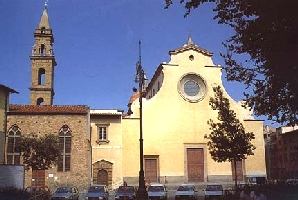
Santo Spirito
In Piazza Pitti there are the house where the Russian writer Fyodor Dostoevsky lived in 1868-1869 while his was writing The Idiot and Paolo dal Pozzo Toscanelli’s home. Toscanelli’s maps lead Christopher Columbus to the discovery of the New World.
Go west through Via Maggio and Via de’ Michelozzi and reach Piazza Santo Spirito, full of bars and pubs for students and artists. During World War II, many anti-fascists took shelter in the library of the Deutsches Institut (German Institute), whose windows overlook the square.
On the northern side of the square there is the church of Santo Spirito, whereas at the southeastern corner Palazzo Guadagni, a Renaissance building, has been transformed into a boarding house.
Proceed west and reach Piazza del Carmine. The church of Santa Maria del Carmine overlooks the square. In the interior, Masaccio’s frescoes decorating the Cappella Brancacci (Brancacci Chapel) are to be admired.
From Piazza del Carmine walk towards the Arno river and reach Borgo San Frediano, full of shoemaker and goldsmith workshops.
Back on the Lungarno, direction Ponte Vecchio, the residences of numerous important Florentine families are to be admired, such as Palazzo Guicciardini and Palazzo Frescobaldi, where Charles of Valois lived in 1301, when he came to Florence during the dispute between White and Black Guelphs.
In Borgo San Jacopo there are Torre dei Marsili (Marsili’s Tower) and Torre dei Belfredelli (Belfredelli’s Tower), both dating back to the 12th century. In Via de’ Ramaglianti once there was a synagogue.
In Via de’ Bardi the signs of the bombs thrown on this part of the city during World War II are still well visible. The first part of Via de’ Bardi leads into Piazza Santa Maria Soprarno, whose name derives from a church once existing in the square.
Via de’ Bardi continues past Piazza Santa Maria Soprarno. The second part of the street winds in particularly peaceful district of Florence, rich in narrow streets. The name of the street derives from the Bardi family. The Bardi where bankers related with the Medici family. They chose to build their residences in one of the poorest districts of Florence, in a street called Borgo Pitiglioso (fleas street).
On the left, there are two 15th-century buildings, Palazzo Capponi delle Rovinate and Palazzo Canigniani, featuring stone façades and protruding cornices. On the portal of the church of Santa Lucia dei Magnoli a glazed-terracotta relief in the style of the Della Robbia can be admired.
At the end of Via de’ Bardi opens Piazza de’ Mozzi. Numerous elegant building overlook the square, such as Palazzo de’ Mozzi (where Pope Gregory X lived during his stay in Florence in 1273), Palazzo Lenzi-Nencioni, Palazzo Torrigiani-Del Nero (with its magnificent mosaics) and Palazzo Torrigiani. These last buildings date back to the 15th century.
On the opposite side of the square there is Museo Bardini. The collector Stefano Bardini (1836-1922) donated the building to the city of Florence. Apart from sculpture and painting masterpieces from the Roman Age to the 18th century, the museum houses a wonderful collection of pottery, medals, Oriental carpets and musical instruments.
Turn towards in Via dei Renai and reach a little square dedicated to the Russian philanthropist Nikolai Demidov, who lived in Florence in the 19th century. The Demidov family made considerable donations to various Florentine charitable institutions and financed the restoration of the Medicean villa in Pratolino, which today is called Villa Demidoff (Italian form for Demidov).
Along Via dei Renai, Palazzo Serristori is to be admired. It is a 16th-century building and Joseph Napoleon’s last residence. His brother Napoleon Bonaparte proclaimed him King of Spain in 1808.
On the right opens Via San Niccolò, which leads to the tower of Porta San Niccolò (San Niccolò gate). The tower is all that remains of the Medieval Florentine gate. After having visited the church of San Niccolò in Oltrarno, going south a brief part of the ancient Florentine city walls are still to be admired on the hill leading to Forte Belvedere.
Our most requested apartments in the Florence historical centre:
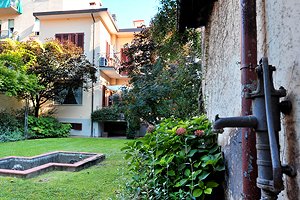 Holiday apartments in pretty villa on the southern outskirts of Florence, in the vicinity of Piazzale Michelangelo. Accommodation for groups of 4/6/8/10/12 people. Air conditioning, Internet connection. Just a few minutes from Florence historical centre.
More details
Holiday apartments in pretty villa on the southern outskirts of Florence, in the vicinity of Piazzale Michelangelo. Accommodation for groups of 4/6/8/10/12 people. Air conditioning, Internet connection. Just a few minutes from Florence historical centre.
More details
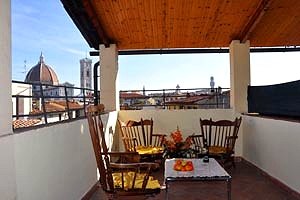 Beautiful apartment sleeping 6+2 in Florence historic centre, at a stone`s throw from Santa Maria Novella railway station. Air conditioning, Internet connection and panoramic balcony with view over the Duomo and the Medici Chapels.
More details
Beautiful apartment sleeping 6+2 in Florence historic centre, at a stone`s throw from Santa Maria Novella railway station. Air conditioning, Internet connection and panoramic balcony with view over the Duomo and the Medici Chapels.
More details
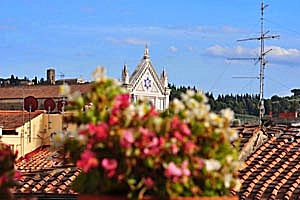 Apartment sleeping 2+1 in the heart of Florence historic centre, in the district of Santa Croce. Panoramic balcony with view over the basilica of Santa Croce, air conditioning, Internet connection, close to the most important Florentine monuments.
More details
Apartment sleeping 2+1 in the heart of Florence historic centre, in the district of Santa Croce. Panoramic balcony with view over the basilica of Santa Croce, air conditioning, Internet connection, close to the most important Florentine monuments.
More details
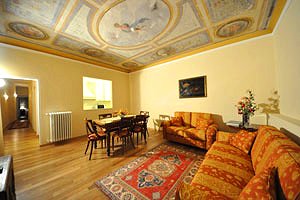 Apartment in the historical centre of Florence a few steps away from the Accademia Gallery. Nearby Piazza Duomo, Piazza Signoria, the Uffizi Gallery . 5+2 beds, Internet Connection and air conditioning.
More details
Apartment in the historical centre of Florence a few steps away from the Accademia Gallery. Nearby Piazza Duomo, Piazza Signoria, the Uffizi Gallery . 5+2 beds, Internet Connection and air conditioning.
More details







